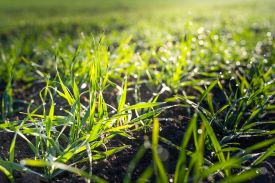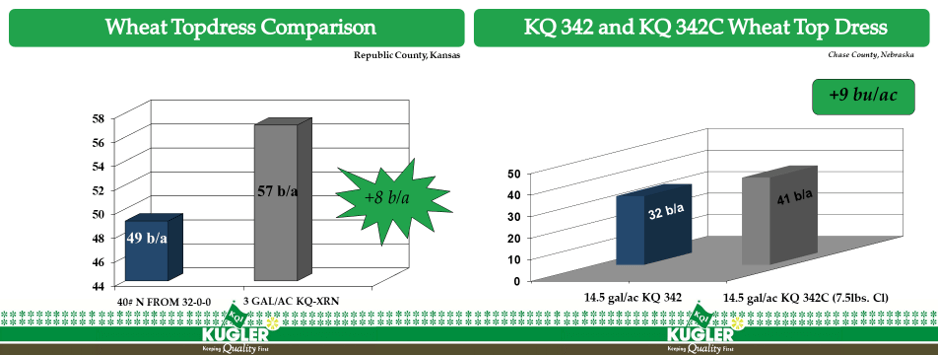Wheat Top-dressing
Feb 24, 2021

A year ago when I was writing about top-dressing wheat, I thought there was no way the coming year would be as crazy as 2019. Then 2020 said “hold my beer.” Pandemics, impeachments, and bizarre elections later, we wonder what 2021 will have in store for us? Well, we had one heck of a cold spell in February to start off the calving season with a bang. The weather of course dictates so many facets of our lives in agriculture. Looking back to last year, we had tremendous adoption of our wheat top-dress program, only to have temperatures reach into the teens 3 nights in a row in mid-April which wrecked our wheat potential. I hope everyone will consider our program again this year despite last year’s disappointment.
We know all about Kugler 342C which has a variety of essential nutrients specific to wheat for top-dress applications. It is a blend of Nitrogen, Potassium, Sulfur, Zinc, and Chloride. Nitrogen requirements on winter wheat are approximately 2 lbs/bu. We do get a nitrogen bump from spring applied N being worth more than fall applied as a greater percentage is used for spikelet formation. Sulfur and Potassium availability can come into question in more no-till environments. We have observed Sulfur deficiency in recent years and while K deficiencies are rare in our soils, availability of K is being more investigated in no till environments due to the nutrient’s immobility in the soil. Chloride is known to be a fundamental component to disease tolerance and photosynthesis in high yielding wheat.(Kugler 342C analysis is: 20#Nitrogen; 3# Potassium; 4# Sulfur; 5# Chloride; & 0.1# Zinc)

In past years we have seen some amplified leaf burn when mixing UAN sources and sulfonylurea herbicides (Finesse, Amber, Olympus, and Powerflex) at top-dress. Quelex herbicide should also be considered as it has a short rotational window to most crops as there may be some uncertainty on later planted wheat. We do need to watch how much Nitrogen we are spraying on wheat in the spring especially if temperatures get relatively high for top-dress timing. I don’t like to recommend over 50% of the total carrier be fertilizer. XRN can help fill that gap as a 70% slow-release that does not burn tissue and is a better option mixed with herbicide or fungicide in the spring.
Copper is a nutrient that has been discussed in the past 10 years. It is an immobile micronutrient that aids in pollen tube formation. It also is essential cell component and key in protein synthesis. An effective method of applying has been somewhat challenging. We have a foliar form called MAX-IN Copper that can be tank mixed with other top-dress herbicides and fertilizers at a use rate of 8 oz/ac. Steady yield responses of 5 bu/ac have been observed with MAX-IN Copper.
Midway Co-op is launching a top-dress special. Apply minimum 5 gal 342C + 1-2 gal XRN+8 oz MAX-IN Copper along with your herbicide and Fungicide of choice (TopGuard or Priaxor) and get application discounts as low as $4/ac. For the cash and carry guys doing it themselves, receive up to $1.50 discount for adopting the whole program. With the later emerging double-crop wheat, our top-dress program will work better a little later in the spring when the wheat can get a little size to it. Talk to your local Midway Co-op branch manager or agronomist for details on all the winter wheat top-dress options for your 2021 Wheat crop. Thanks for your business!
We know all about Kugler 342C which has a variety of essential nutrients specific to wheat for top-dress applications. It is a blend of Nitrogen, Potassium, Sulfur, Zinc, and Chloride. Nitrogen requirements on winter wheat are approximately 2 lbs/bu. We do get a nitrogen bump from spring applied N being worth more than fall applied as a greater percentage is used for spikelet formation. Sulfur and Potassium availability can come into question in more no-till environments. We have observed Sulfur deficiency in recent years and while K deficiencies are rare in our soils, availability of K is being more investigated in no till environments due to the nutrient’s immobility in the soil. Chloride is known to be a fundamental component to disease tolerance and photosynthesis in high yielding wheat.(Kugler 342C analysis is: 20#Nitrogen; 3# Potassium; 4# Sulfur; 5# Chloride; & 0.1# Zinc)

In past years we have seen some amplified leaf burn when mixing UAN sources and sulfonylurea herbicides (Finesse, Amber, Olympus, and Powerflex) at top-dress. Quelex herbicide should also be considered as it has a short rotational window to most crops as there may be some uncertainty on later planted wheat. We do need to watch how much Nitrogen we are spraying on wheat in the spring especially if temperatures get relatively high for top-dress timing. I don’t like to recommend over 50% of the total carrier be fertilizer. XRN can help fill that gap as a 70% slow-release that does not burn tissue and is a better option mixed with herbicide or fungicide in the spring.
Copper is a nutrient that has been discussed in the past 10 years. It is an immobile micronutrient that aids in pollen tube formation. It also is essential cell component and key in protein synthesis. An effective method of applying has been somewhat challenging. We have a foliar form called MAX-IN Copper that can be tank mixed with other top-dress herbicides and fertilizers at a use rate of 8 oz/ac. Steady yield responses of 5 bu/ac have been observed with MAX-IN Copper.
Midway Co-op is launching a top-dress special. Apply minimum 5 gal 342C + 1-2 gal XRN+8 oz MAX-IN Copper along with your herbicide and Fungicide of choice (TopGuard or Priaxor) and get application discounts as low as $4/ac. For the cash and carry guys doing it themselves, receive up to $1.50 discount for adopting the whole program. With the later emerging double-crop wheat, our top-dress program will work better a little later in the spring when the wheat can get a little size to it. Talk to your local Midway Co-op branch manager or agronomist for details on all the winter wheat top-dress options for your 2021 Wheat crop. Thanks for your business!